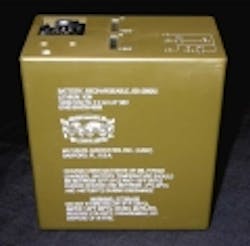Night vision image-intensifier tubes re-invented for the digital age by coupling them to digital cameras with relay lenses
EAGLEVILLE, Pa., 14 July 2010. The pursuit of network-centric warfare and the digital battlefield is fueling attempts to re-invent the analog image intensifier tube common to night-vision goggles (NVG) and other kinds of night-fighting equipment to enable this low-light sensor to produce digital imagery that can be shared over tactical networks and viewed on digital displays.
The analog image-intensifier tube is a staple of more than half a million existing night-vision sensors, such as the AN/PVS-14 night-vision monocular. Although these devices remain valuable for night vision in military and law-enforcement applications, the images they produce are not much use to anyone beyond the person looking into the night-vision device.
Electro-optics systems designers, however, are starting to consider additions to the venerable image-intensifier to convert its analog signal into digital data. Designers are doing this by coupling the image-intensifier tube to digital cameras by adding fast relay lenses. Do this, and imagery from the tube can be viewed on digital displays, sent over digital networks to nearby forces and higher command authorities, or processed for multispectral imaging.
"Everyone wants to see things digitally," explains Angelique Irvin, president and chief executive officer of electro-optics specialist Clear Align in Eagleville, Pa. Clear Align and other electro-optical companies like Electrophysics Corp. in West Fairfield, N.J., are providing the fast relay lenses that help convert image-intensifier tube signals into digital information.
Relay lenses can convert images from one size to another without losing any light. The relay lens transmits the tube's image to a digital camera, which records the information for storage, transmitting on a network, or for additional digital signal processing to fuse the tube's imagery with other sensors or for enhancement for intelligence analysts.
Irvin explains there are two ways to couple photos and video from an image-intensifier tube to a digital camera: either use a fast relay lens, or use a fiber optic taper, which like a relay lens converts an image from small to large, or from large to small.
Irvin cautions that using a fiber optic taper not only is expensive, but also is a permanent solution. "People will still use those night-vision goggles," Irvin says. "With a relay lens, you can pop a camera on it and look at images on a screen, rather than through the NVG lenses."
For more information contact Clear Align online at www.clearalign.com, or Electrophysics Corp., a Sofradir Group Company, at www.electrophysics.com.
Follow me on TwitterJoin the PennWell Aerospace and Defense Media Group on Linkedin at http://bit.ly/9MXl9
Become a fan of Military & Aerospace Electronics on Facebook at http://bit.ly/1VGM0Q
Post your aerospace and defense-related material to the #milaero community on Twitter. Use the #milaero hashtag.
Join your industry colleagues in the Command Post community online at http://community.milaero.com
